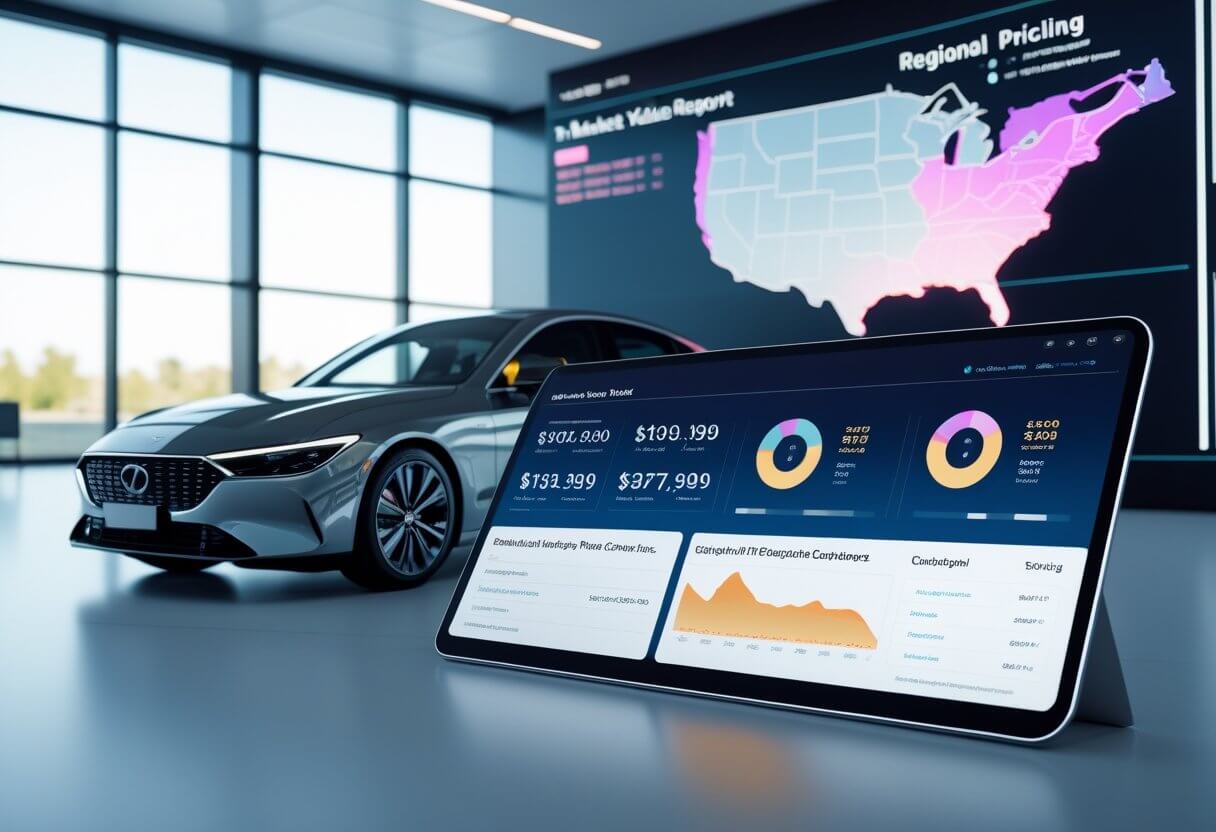
True Market Value: Accurate AI-Based Vehicle Pricing Guide
Finding the true market value of a car isn’t always easy. Sticker prices, trade-in offers, and dealer quotes often don’t reflect what the car is actually worth. That’s where VINspectorAI’s True Market Value service makes a difference. By analyzing accident history, ownership records, mileage, and regional market trends with advanced AI, it gives you the real price of a vehicle today.

What Is the True Market Value of a Car?

True market value represents what buyers are actually paying for vehicles with similar specifications, histories, and conditions in a specific region. It is distinct from a car's sticker price or standard trade-in offer, relying instead on up-to-date data and real market transactions to arrive at a fair, data-driven estimate.
How Does True Market Value Differ From MSRP and Trade-In Value?
The manufacturer’s suggested retail price (MSRP) is simply a starting point set by automakers and rarely reflects actual selling prices. Dealerships often offer discounts or incentives, so few vehicles sell at MSRP.
Trade-in value is what a dealer is willing to pay for a vehicle towards another purchase. This figure usually factors in the dealer’s resale risk and profit margin, meaning it’s often lower than what a seller might get in a private sale.
True market value (used by services like Edmunds True Market Value or VINspectorAI) looks at local sales data, accident records, vehicle conditions, and current demand. This sets it apart by providing a fair price grounded in recent, real-world transactions—closer to what a knowledgeable buyer and seller could agree upon.
Table: MSRP vs. Trade-In vs. True Market Value
Value Type | Definition | Typical Use | How It’s Calculated |
|---|---|---|---|
MSRP | Manufacturer’s recommended starting price | New car sales | Automaker suggested |
Trade-In Value | Dealer’s offer towards another car | Trading in at a dealership | Depreciated estimate, usually lower than retail |
True Market Value | Price based on actual market sales and car specifics | Buying/selling used vehicles | Data-driven, reflects real conditions |
For a deeper breakdown of vehicle reports, see our Detailed VIN Reports Guide.
The Importance of Actual Market Conditions
Market conditions directly influence car pricing and residual values. When demand for certain vehicles rises—for example, for fuel-efficient cars during periods of high gas prices—their market value goes up.
Regional differences matter as well. A convertible might command a higher resale value in California than in Minnesota due to climate preferences. Economic trends, supply chain issues, and model popularity all impact current market prices.
Relying on up-to-date market data, rather than only historical averages or static guides, is key to understanding a vehicle’s fair price today. Data-driven platforms use this approach to deliver TMV reports based on relevant factors for a specific vehicle and region.
Why Is True Market Value Important When Buying or Selling a Car?
Accurate valuation protects buyers from overpaying and helps sellers obtain a fair price for their vehicle. Inaccurate estimates can result in financial loss or deals that fall through.
Many private buyers and sellers turn to services like Edmunds TMV or VINspectorAI to gain transparency and confidence in pricing. These reports adjust for each vehicle’s unique condition, ownership records, accident history, and even maintenance.
An informed valuation is especially important in the used car market, where vehicle history and condition can influence resale value by thousands of dollars. Sellers gain negotiating strength, and buyers avoid costly surprises by referencing a clear, data-backed estimate of what the car is really worth.
💡 Pro Tip: A car’s market value is only as accurate as the inspection behind it. Use our Used Car Inspection Checklist: Spot Hidden Damage Before You Buy before relying on the numbers.
How VINspectorAI’s True Market Value Service Works

VINspectorAI calculates car valuations by combining artificial intelligence, vast datasets, and up-to-date regional market data. The service delivers clear insights for accurate pricing, tailored to each vehicle.
Leveraging Advanced AI Algorithms
VINspectorAI’s core uses machine learning models designed for vehicle valuations. These algorithms evaluate a car’s unique attributes, such as year, make, model, trim, and mileage.
They also consider detailed factors like ownership history and reported maintenance. AI models continuously improve by analyzing new listings, transaction outcomes, and user feedback.
By recognizing subtle patterns humans may overlook, the system adjusts its pricing recommendations as market conditions shift. This allows VINspectorAI to offer pricing aligned with real-world trends, not just static guides.
Utilizing Extensive Data Sources
VINspectorAI aggregates data from national databases, auto marketplaces, insurance records, and manufacturer sources. Information reviewed includes accident history, service records, title changes, and open recalls.
A dedicated data collection process ensures that each Vehicle Identification Number (VIN) brings in up-to-date and accurate records. By cross-referencing each source, VINspectorAI identifies discrepancies and validates critical pricing factors.
This wide-ranging data drives insights that set it apart from generic car valuation tools, allowing for precise, vehicle-specific market pricing.
Analyzing Regional Market Trends
Market trends vary significantly between regions and even cities. VINspectorAI assesses local demand, average time to sell similar cars, and current marketplace pricing.
By matching each vehicle’s profile to historical sales and listings close to the user's location, the platform creates a local benchmark. It factors in regional influences like climate, seasonality, and economic activity.
This analysis ensures each valuation accurately represents what buyers are willing to pay in a specific market context.
Key Factors Influencing Vehicle Valuation
📊 U.S. Vehicle Value & Depreciation Statistics (2024)
Statistic | Average / % | Why It Matters |
|---|---|---|
Average annual car depreciation | ~15–20% in the first 3 years | Cars lose value fastest early on |
Impact of a major accident on resale | -10% to -25% value drop | Even repaired cars lose value |
Mileage effect (over 100k miles) | Up to -40% vs. same model low-mileage | Odometer strongly impacts value |
Regional differences (SUVs) | Higher resale in colder states | Local demand shifts pricing |
Cars with salvage/rebuilt titles | 20–40% lower resale | Market penalizes risky titles |
Estimates based on Experian, Edmunds, and NADA data.
Vehicle valuation depends on a combination of tangible and data-driven attributes, including the car’s condition, detailed history, recorded mileage, and market trends influenced by location and timing. Understanding these core factors helps ensure a valuation accurately reflects the vehicle’s current worth.
Condition, Make, Model, and Age
A car's condition has a direct and measurable impact on its value. Well-maintained vehicles with minimal wear, a clean interior, and no visible damage typically command higher valuations.
The make and model also play major roles. Certain brands like Toyota and Honda are known for reliability, which helps them retain value longer than less sought-after models. Luxury makes, including BMW or Mercedes, may depreciate faster due to higher maintenance costs over time.
Age of the vehicle is another critical element. Most vehicles lose value quickly in the first few years, then depreciate more slowly. A seven-year-old sedan, for example, will almost always be worth less than a three-year-old SUV in comparable condition, regardless of make.
Mileage and Odometer Reading
Mileage is a straightforward but crucial metric. Lower odometer readings generally mean less mechanical wear and a longer expected life for the car. Buyers and sellers often use mileage bands—such as under 40,000; 40,000-80,000; or over 100,000 miles—to categorize vehicles for price comparisons.
A car with unusually high mileage for its age is typically valued lower, as it indicates more use and possibly more required maintenance. Conversely, a well-maintained, low-mileage vehicle of the same year and model will command a premium.
Accident History and Vehicle History Reports
Accident history heavily impacts a vehicle’s worth. Cars with prior accidents, even if fully repaired, tend to have lower resale values. Frame or structural damage is particularly concerning for buyers and often leads to significant depreciation.
Vehicle history reports—generated using the VIN—give buyers a clear view of any incidents, title changes, ownership records, and major repairs. These reports are essential documents during transactions. Recent accidents or multiple damage events found in a vehicle history report can signal reliability concerns and drive valuations down.
Transparency is crucial. Vehicles with a clean, well-documented history are more appealing and typically secure higher prices. Cars with incomplete or questionable records may struggle to attract serious buyers.
Seasonality and Regional Differences
Seasonal trends and geographic differences influence demand and pricing. For example, convertibles and sports cars tend to see increased values in spring and summer, while four-wheel-drive vehicles and SUVs are in higher demand during fall and winter, especially in colder regions.
Regional market dynamics also affect value. A truck that’s in high demand in rural or industrial areas may fetch a higher price there than in urban environments. Conversely, compact cars are more desirable in cities due to easier parking and better fuel efficiency.
Local regulations, taxes, or environmental standards can further impact a specific car’s desirability. Sellers and buyers should consider these regional and seasonal variables to gauge accurate, real-world market values.
Accident history heavily impacts a vehicle’s worth. Cars with prior accidents, even if repaired, usually lose value. That’s why checking an Accident History Report: Check Car Damage Before You Buy is a must before negotiating the price.
Comprehensive Data Sources for Market Value Estimation
An accurate vehicle valuation depends on a blend of trusted data sources, covering everything from ownership and maintenance details to market price comparisons. By utilizing multiple industry-standard tools and databases, the valuation process becomes both thorough and reliable.
Integration of Ownership and Maintenance Records
VINspectorAI incorporates detailed ownership and maintenance records into every vehicle analysis. These records provide insights into how a car or truck has been cared for, including service intervals, replacement parts, and any periods of neglect.
Reliable sources such as dealership service logs and independent repair shop entries are reviewed to determine the consistency of upkeep. Frequent routine maintenance, such as oil changes or brake inspections, can positively impact value, while irregular records may suggest potential issues.
Analyzing the number and type of previous owners helps establish patterns that affect long-term reliability. For example, a vehicle with a single owner and regular maintenance may be valued higher than one with multiple owners and spotty records. This granular level of detail helps ensure a more precise market estimate.
Comparing VINspectorAI with Other Valuation Platforms
VINspectorAI, Kelley Blue Book, and NADA use different approaches to vehicle valuation, each with its advantages and limitations. These differences can impact how prices are determined, what data is included, and the overall accuracy of each service.
Kelley Blue Book and NADA: Strengths and Differences
Kelley Blue Book (KBB) and NADA Guides are two of the most recognized vehicle valuation sources in the U.S. KBB is known for its consumer-facing website, providing easy-to-access trade-in, private party, and suggested retail values based on historical data and dealer inputs.
VINspectorAI differentiates itself by assessing a vehicle’s exact VIN, integrating AI to analyze not just broad market trends but also the specific condition, history, and location of each car. This tailored approach provides a valuation that is highly personalized compared to the more generalized methods of KBB and NADA.
Table: VINspectorAI vs. KBB vs. NADA
Platform | Data Sources | Accuracy | Personalization | Best For |
|---|---|---|---|---|
VINspectorAI | Live sales data, VIN-specific history, AI analysis | ✅ High | ✅ Tailored to vehicle condition & location | Buyers & sellers wanting real-time accuracy |
Historical averages, dealer input | Medium | ❌ Generalized estimates | Quick trade-in or resale estimates | |
NADA | Market averages, dealer network | Medium | ❌ Less specific | Dealers, lenders, insurance use |
Role of Data Accuracy and Relevancy
Data sources and accuracy play a critical role in vehicle valuation. KBB and NADA rely heavily on aggregated market averages and historical transaction data, which can lag behind real-time changes in supply or demand.
VINspectorAI’s model pulls live data from a variety of sources, such as recent sales, accident history, ownership records, and regional trends. This approach allows for more precise valuation outputs that reflect today’s market.
Additionally, by factoring in individual vehicle condition and real-world pricing in specific local markets, VINspectorAI provides more relevant pricing for unique vehicles. This results in valuations that are responsive to micro-market trends and recent events, which may be an advantage for users seeking up-to-date information.
True Market Value only works when paired with a reliable VIN report. As we explained in Why You Should Check a Car’s VIN: VINspectorAI Review & Benefits, a VIN check reveals hidden issues like accident history or salvage titles that can drastically affect a car’s price.
🔚 Conclusion: Don’t Guess, Know Your Car’s Real Value
When buying or selling a car, guessing the price can cost you thousands. A True Market Value report from VINspectorAI shows exactly what your car is worth today—based on its VIN, accident history, mileage, and real market trends.
✅ Stop relying on inflated dealer quotes.
✅ Avoid underselling your vehicle.
✅ Get the confidence to negotiate smart.
👉 Check your car’s True Market Value now with VINspectorAI and make your next deal with certainty.
Frequently Asked Questions
Get answers to common questions about True Market Value: Accurate AI-Based Vehicle Pricing Guide
Uncover Complete Vehicle History Reports
Discover critical vehicle information before you buy. Our VIN decoder reveals accident records, title status, recalls, and service history to help you make informed decisions.
Related Articles
Explore Tags
More from Automotive Technology

Get a 100% free auto history check with VinspectorAI. No hidden fees. Uncover accidents, ownership, theft & more. Test our full AI analysis with a free demo!
Transparent VIN checks build trust in auto sales. Give buyers clear vehicle history reports & integrate checks for confident, informed car purchases.

VINspectorAI uses AI to uncover accidents, fraud, recalls & true value — ensuring safe, smart purchases. Why You Should Check a Car’s, check now with vinspectorai.